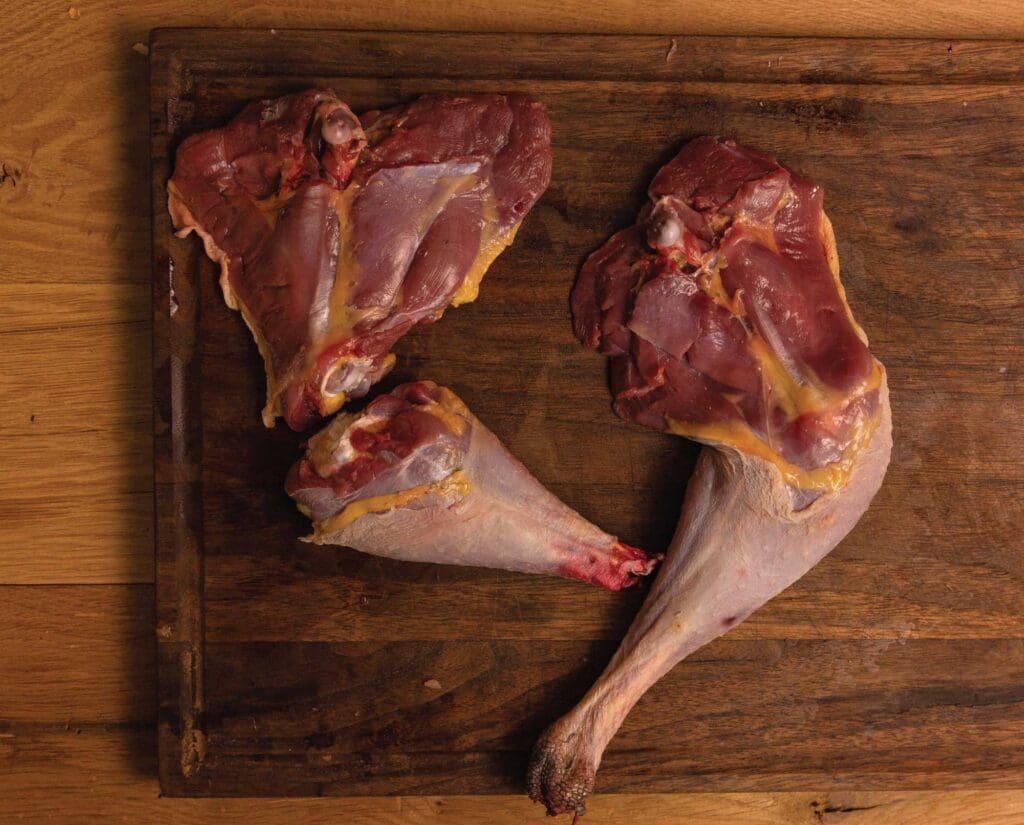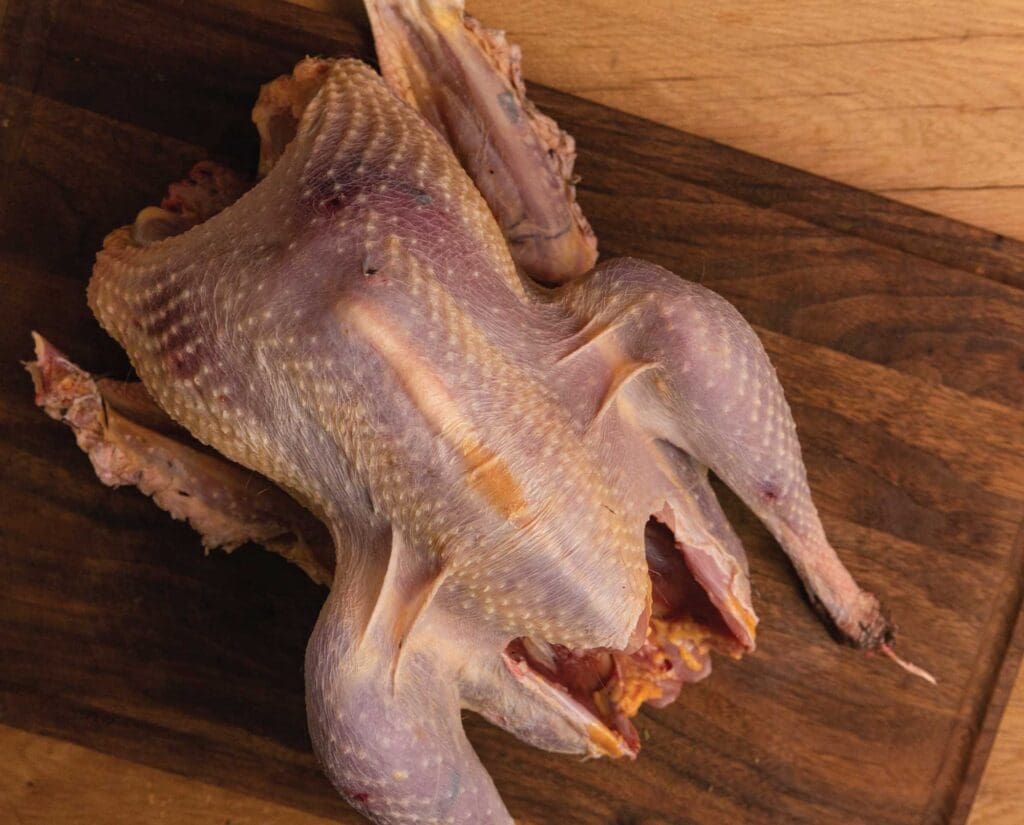As an avid hunter and outdoor enthusiast, I love preparing wild game to enjoy with family and friends One of my favorites is wild turkey With its rich, savory meat, the wild turkey provides a bounty of delicious cuts when properly processed. In this article, I’ll walk through the full process, from field dressing to final preparations in your kitchen.
Field Dressing a Wild Turkey
The first step after harvesting your turkey is field dressing Here’s how it’s done
-
Place the turkey breast up and bend the legs forward to expose the vent area. Carefully make an incision between the vent and breastbone. Be careful not to cut too deep and puncture intestines.
-
Reach inside the cavity and cut around the vent, anus, and reproductive organs. Remove all of these, but be careful not to rupture the intestines or urinary tract.
-
Make an incision up the back of the bird from vent to neck Reach in and remove any organs still attached Scoop out any remaining blood clots or debris from the cavity.
-
Many people remove the crop, windpipe, and gullet at this point too. The crop is a pouch along the neck that you can cut away after tying it off with string to prevent contents leaking.
-
Wipe out any remaining blood and debris with paper towels, grass, or a cloth. Rinse if water is available.
Proper field dressing cools the carcass, removes dirt/debris, and prepares the bird for transport from the field.
Transporting Your Turkey
Once field dressed, get your turkey cooled down as quickly as possible. Place it in a game bag or cooler to lower body temperature. This prevents spoilage and preserves meat quality. Transport from field to home or camp as soon as you can.
If temperatures are warm, it’s especially important to cool your turkey right away. You can quarter the bird to increase cooling if needed. Just be sure to label parts so you can reconstruct the carcass later.
Hanging and Aging Wild Turkey
Unlike venison, turkeys don’t need to hang and age for long periods. In most cases, you can begin butchering within a day or two of harvesting. If you do age it, one week is sufficient for flavor enhancement.
Keep your turkey at a temperature between 32-40°F while aging. You can hang it whole or quartered from a meat pole, or place it in a refrigerator/cooler if one is available. Monitoring temperature is key though, as you don’t want spoiled meat.
Plucking vs Skinning Your Turkey
Before butchering, you’ll need to remove feathers. You can either pluck or skin the turkey. Plucking takes more time but saves the skin for crisping up in the pan. Skinning is quicker but you lose the skin completely.
If plucking, you’ll need to scald the carcass in hot water before plucking. Soak for a few minutes until feathers slip out easily. Then begin plucking away all feathers. Use a knife for any stubborn spots.
If skinning, simply make an incision between meat and skin. Peel the skin away from breast, legs, and thighs. Cut off wings and skin them individually.
Either method works well. Choose plucking if you want crispy skin for your finished dishes.
Butchering Your Wild Turkey
Once feathers are removed, it’s time to break down your turkey into primal cuts. Here are the steps:
Removing the Breasts
-
Lay the turkey on its back and pull each leg forward to expose the breastbone.
-
Using a sharp knife, slice down along one side of the breastbone from cavity opening up towards the wing.
-
Run knife down along rib cage to separate breast meat from back/spine.
-
Repeat on the other side to remove the entire breast section.
-
Carefully trim remaining skin, fat, and sinew from breasts. Rinse under cool water.
Save tenderloins attached to the backbone for stew meat if desired.
Removing Legs and Thighs
-
Flip the turkey over so backbone faces up. Cut through skin between thigh and carcass.
-
Bend leg out and back to pop hip joint. Cut through joint to remove leg.
-
Slice through knee joint to separate drumstick from thigh.
-
Repeat steps on other leg. Rinse thoroughly.
Removing Wings
-
Cut through wing joint where it attaches to carcass.
-
Slice between bones to separate drumette from flat/wingette.
-
Skin wings if desired, though it takes time to remove small feathers.
Removing Giblets
-
Lay turkey on back again. Make a shallow slice into lower abdomen.
-
Reach in and remove heart, liver, gizzard one by one.
-
Slice gizzard open and rinse out contents. Peel lining off.
-
Rinse giblets thoroughly. Soak in milk or saltwater overnight to mellow flavors.
And with that, you’ve broken down the entire turkey into its basic cuts!
Cleanup and Sanitation
Proper sanitation is crucial when processing wild game. Be sure to:
-
Keep your hands, knives, and surfaces clean at all times. Wash frequently.
-
Rinse all meat cuts under cold water after separating from carcass. Pat dry.
-
Use separate cutting boards/surfaces for raw turkey vs. other foods. Avoid cross-contamination.
-
Refrigerate all cuts as soon as possible, within 2 hours max. Freeze if not using within 2-3 days.
Following cleanliness rules prevents dangerous bacterial growth on your fresh turkey meat.
Packing and Freezing Wild Turkey
Wild turkey can be stored in either fresh or frozen form. For maximum shelf life, freezing is best. Here are some tips:
-
Allow all meat cuts to air dry for 1-2 hours before freezing. Pat dry with towels if needed. Moisture damages quality.
-
Place portions in vacuum seal or zip-top bags. Remove excess air before sealing. This prevents freezer burn.
-
Label bags with cut type and date processed. Place like cuts together in freezer.
-
Frozen wild turkey keeps 6-12 months at 0°F. Thaw in fridge before use, not on counter.
Proper freezing preserves your turkey’s flavor and texture when you’re ready to cook it for upcoming meals.
Favorite Recipes for Wild Turkey Cuts
The work’s not done once your turkey is safely stored away. You still need to prepare delicious meals to enjoy it! Here are some of my personal favorite recipes for wild turkey:
For Breasts:
- Maple balsamic grilled turkey breast
- Turkey saltimbocca with prosciutto and sage
- Seared turkey cutlets with cranberry relish
For Legs and Thighs:
- Slow cooker turkey leg confit
- Smoked turkey drumsticks
- Braised turkey thighs in red wine sauce
For Wings:
- Crispy buffalo turkey wings
- Turkey wing gumbo
- Grilled curry turkey wings
For Giblets:
- Fried turkey gizzards and hearts
- Chopped turkey liver pâté
- Turkey heart skewers

Butchering Wild Turkey Tenderloins
The tenderloins are that smaller, finger-like piece of meat hidden below the breasts. They have different muscle striations and should be cooked separately. On a large spring gobbler, they can be the size of a pheasant breast. As you might have guessed, they are the most tender cut on a wild turkey. You shouldn’t need a knife to remove them; you can carefully peel turkey tenderloins off the bone.

Learn the best practices for butchering, carving and cooking your wild spring turkey
When people most people think of turkey, domestic or wild, they envision a whole bird. The skin is crispy, caramelized from a long oven roast, and stuffed to the brim as a dinner table centerpiece. This was the picture I had in my mind when I bagged my first wild turkey over 12 years ago. I treated it no differently than a Thanksgiving bird. Upon trying to carve and bite into the thighs, I immediately realized that one does not simply roast a wild turkey whole.
Listen to more articles on Apple | Google | Spotify | Audible
While I still know alleged wild game chefs that do this and proclaim it works based on XYZ, I think they’re spitting on my cupcake and telling me it’s frosting. The truth is that wild turkey meat can taste incredible if you know how to butcher and cook it correctly.
Here is how it’s done.

How to Pluck and Clean a Turkey with Steven Rinella – MeatEater
FAQ
What do you soak wild turkey in before cooking?
Do you have to gut a turkey right away?
How to cook wild turkey thighs?
Low and slow are the keys to cooking wild turkey thighs. Alex Robinson The leg meat on wild turkeys can be juicy, tender, and delicious, as long as you treat it right. Pulling them off your bird is pretty simple. Skin down to the knee joint and peel away the skin from both sides of the leg.
How do you butcher a wild turkey?
Butcher a wild turkey right away, especially if you are harvesting innards. After each cut is removed from the turkey, clean and wash the meat thoroughly. Make sure to wash off blood, feathers, and dirt. Pat the meat dry and also let it air dry on a rack before freezing or cooking.
How do you cut a turkey leg?
The leg meat on wild turkeys can be juicy, tender, and delicious, as long as you treat it right. Pulling them off your bird is pretty simple. Skin down to the knee joint and peel away the skin from both sides of the leg. Then press the leg away from the body until you pop the hip joint. Cut from the inside of the leg, separating it from the body.
What is a wild turkey?
When people most people think of turkey, domestic or wild, they envision a whole bird. The skin is crispy, caramelized from a long oven roast, and stuffed to the brim as a dinner table centerpiece. This was the picture I had in my mind when I bagged my first wild turkey over 12 years ago. I treated it no differently than a Thanksgiving bird.
